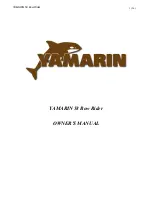
3.4
S
ECTION
3 • U
SING
Y
OUR
B
OAT
220 Select
prevent it from flying about if the boat
encounters rough water or weather.
5. P
ERSONAL
F
LOTATION
D
EVICES
(PFD’
S
)
•
Operator must instruct all passengers on
location and use of PFD’s (See
Section 1-
Safety, for type and usage).
•
Children less than sixteen (16) years of age and
all non-swimmers, adults as well as children,
must wear properly-sized PFDs at all times when
aboard.
•
ALL passengers should wear PFDs. By the time
someone falls overboard, it can be to late for
them to put on a PFD and fasten it properly.
This is especially true in colder waters, below
70
o
F, where survival time, before hypothermia
sets in, is measured in minutes.
•
If there are passengers not wearing PFDs, the
PFDs must be readily accessible. “Readily
accessible” means out of the storage bag and
unbuckled.
•
All throwable flotation devices (cushions, rings,
etc.) must be right at hand.
6. P
ASSENGER
I
NSTRUCTION
AND
L
OCATION
•
Everyone on board must be told about the boat’s
behavior from starting to getting up on plane.
•
Before the operator does any high-speed
maneuvers or rapidly accelerates or decelerates
the boat, passengers must be warned to sit and
hold on and must heed the warning.
•
The operator may have to make rapid changes
in speed and/or direction to avoid a problem,
with little or no time for alerting passengers. It is
critical that all passengers be seated in the
designated seating areas and holding on to
prevent falling overboard or getting knocked
about in the boat at all times when the boat is
underway.
7. S
TARTING
T
HE
E
NGINES
The engine operation and maintenance manual
furnished with your boat describes pre-start and
starting procedures. We urge you to thoroughly read
and understand your engine manual.
Listed below are basic pre-start and starting
reminders. These are not a substitute for the engine
manufacturer’s specific recommendations.
Open the engine compartment and check for the
smell of gasoline.
•
IF YOU SMELL GASOLINE, get everyone off
the boat, do not operate any electrical switches
or light any matches, lighters, etc. Get trained
help to find and fix the problem, before starting
the engine or operating any switches on the boat.
•
If you DO NOT smell gasoline.
1. Check all fluid levels and any other necessary
checks as specified in Section 8 and in the
engine manual.
Gasoline vapors can explode
Before starting the engine, open engine compartment
and check for gasoline smell.
•
If you smell gasoline, do not start engine; get
everyone off the boat and get trained help to find
and fix the problem.
If there is no gasoline smell, perform checks specified
by manual, then and only then, close engine
compartment and run blower for at least 4 minutes
before starting.
!
DANGER
Summary of Contents for 220 Select
Page 1: ...220 Select Owner s Manual Part Number MRP 1803639 Sea Ray Owner s Manual...
Page 2: ......
Page 4: ...220 Select II...
Page 12: ...220 Select X THIS PAGE WAS LEFT INTENTIONALLY BLANK...
Page 30: ...220 Select 1 18 SECTION 1 SAFETY THIS PAGE LEFT INTENTIONALLY BLANK...
Page 52: ...3 8 SECTION 3 USING YOUR BOAT 220 Select THIS PAGE WAS LEFT INTENTIONALLY BLANK...
Page 60: ...4 8 SECTION 4 BILGE UNDERWATER GEAR 220 Select THISPAGEWASLEFTINTENTIONALLYBLANK...
Page 72: ...6 10 SECTION 6 ELECTRICAL SYSTEM 220 Select THIS PAGE INTENTIONALLY LEFT BLANK...
Page 84: ...7 10 SECTION 7 OPTIONS ACCESSORIES 220 Select THIS PAGE INTENTIONALLY LEFT BLANK...
Page 94: ...220 Select 9 4 SECTION 9 CARE REFINISHING THIS PAGE WAS LEFT INTENTIONALLY BLANK...
















































